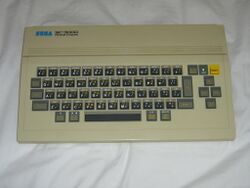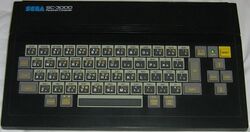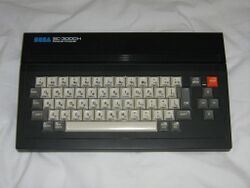SC-3000
From Sega Retro
 
| ||||||||||||||||||||||||||||||||||||||||||||||||||
| SC-3000 | ||||||||||||||||||||||||||||||||||||||||||||||||||
|---|---|---|---|---|---|---|---|---|---|---|---|---|---|---|---|---|---|---|---|---|---|---|---|---|---|---|---|---|---|---|---|---|---|---|---|---|---|---|---|---|---|---|---|---|---|---|---|---|---|---|
| Manufacturer: Sega | ||||||||||||||||||||||||||||||||||||||||||||||||||
| Variants: SC-3000H | ||||||||||||||||||||||||||||||||||||||||||||||||||
| Add-ons: Super Control Station SF-7000, SP-400, Data Recorder SR-1000 | ||||||||||||||||||||||||||||||||||||||||||||||||||
|
The SC-3000 (Sega Computer 3000) is the first and only computer to be designed and manufactured by Sega. It was first released in July of 1983 in Japan, and serves as the home computer equivalent of the SG-1000 cartridge-based video game console. The SC-3000, often known simply as the "Sega Computer" or even just the "Sega", is an 8-bit home computer almost identical in nature to the SG-1000, but with a built-in keyboard and support for more hardware expansions.
Unlike later Sega systems, the SC-3000 did not receive a worldwide release, but in markets where it did compete, including Japan, Australia, New Zealand, France, Italy and Finland, the computer fared well as a low price, entry-level machine for the home. By 1985, the SC-3000 had been displaced by more popular computer standards, but is nevertheless said to have fared better than the SG-1000 console on the global stage, and has a strong group of followers to this day.
The SC-3000 was also Sega's last home computer to be released to the general public. The company would partner with Amstrad and IBM for the Amstrad Mega PC and TeraDrive respectively in later years, but other endeavours such as the extremely rare Sega AI Computer saw only a small fraction of the success the SC-3000 received, and were built with very different aims.
Contents
Hardware
As a home computer, the SC-3000 was designed to be an affordable machine for use in a home environment, primarily for business and educational use. However, as with most home computers of the era, the device became a method of playing video games.
The SC-3000 comes with a 64-key keyboard mounted on the top of the unit, a cartridge port on the right hand side and two DE-9 joystick ports on the left. On the back, the system has a power switch and power supply, cassette, printer, monitor and television ports typical of the era. It is a relatively light and compact machine which is most commonly found in black, though white and red variants were also available in Japan.
The SC-3000 is fully compatible with almost all software and accessories designed for the SG-1000 or SG-1000 II, save for some BASIC cartridge variants and peripherals such as the SK-1100. In many situations the reverse is also true - the SK-1100 allowing the SG-1000 to interface with some SC-3000 software and accessories.
There are two major models of the SC-3000 - the standard SC-3000 model with rubberised keys, and an upgraded SC-3000H variant from later in the year, with a full-travel mechanical keyboard. Contrary to popular belief, both systems are otherwise identical aside from keyboard technologies, although the improved keyboard led to the SC-3000H being more expensive at launch. A third model, known as the SC-5000 is also known to exist, but very little is known about this unit.
By default, the SC-3000 has 2kB of work RAM, 16kB of VRAM and 32kB of ROM. The system's main RAM is dictated by the cartridge inserted into the machine, and the system will not function if the cartridge port is empty. RAM only becomes an issue when dealing with software not distributed on cartridge, and so, even though the systems are extremely similar, differing RAM requirements from software is not an issue that can affect the SG-1000.
For the most part, the SC-3000 was designed to be used in conjunction with a BASIC cartridge. BASIC Level II A offers no extra RAM, meaning only the standard 2kB is available, BASIC Level III A offers 16kB and BASIC Level III B offers 32kB. The values were often combined with the VRAM figure to create confusingly titled "16K", "32K" and "48K" varieties of the SC-3000 (neither of which are strictly accurate descriptions). Software intended for the "32K" SC-3000 will be incompatible with the "16K" variant, though those with 48K SC-3000s could run just about anything. The BASIC cartridges also double up as a programming language, allowing users to create their own software.
The SC-3000 hardware is comparable to the original MSX computer standard or the ColecoVision games console. Though in most regions the SC-3000 retailed at a cheaper price than many of its competitors, it was outclassed from a technical perspective at launch by more powerful (albeit more expensive) home computers from the likes of Commodore.
On its own, the SC-3000 offers very few features over the SG-1000, but with the addition of a Data Recorder SR-1000, it is possible to load and save software to compact cassette. Perhaps more notably, 3-inch floppy disk support could be given to the computer via the Super Control Station SF-7000 add-on (which ups the RAM even further by adding 64kB, among other features). Documents can also be printed through the SP-400 printer.
The SC-3000 was roughly on par with the original MSX standard, which was largely identical in hardware, but with the MSX having a higher amount of built-in program RAM and more expandable program RAM, though both relied on the VRAM for graphics data, giving them identical graphical capabilities. The SC-3000 was a generally more powerful computer than the Commodore 64 (C64), the most powerful Western home computer at the time. The SC-3000's Z80 CPU has a clock rate of 3.579545 MHz in NTSC and 3.546893 MHz in PAL, several times faster than the C64's 6502 CPU which has a clock rate of 1.022727 MHz in NTSC and 0.985248 MHz in PAL.[1] The SC-3000's Z80 has a processing performance of 0.519034 MIPS in NTSC and 0.514299 MIPS in PAL, higher than the C64's 6502 which has a processing performance of 0.439772 MIPS in NTSC and 0.423656 MIPS in PAL.[2] The SC-3000's SRAM/ROM bus has an access time of 279 ns in NTSC and 281 ns in PAL for fetching opcodes, and 520 ns for memory read/write,[3] faster than the C64's DRAM/ROM bus which has an access time of at least 978 ns in NTSC and 1015 ns in PAL. The SC-3000's VRAM write bandwidth during active display is 174.794 KB/s in NTSC and 181.112 KB/s in PAL,[4] several times faster than the C64's DRAM write bandwidth of 50 KB/s.[1] The SC-3000's higher bandwidth means it could access and transfer more sprite and tile data at a faster rate than the C64. The SC-3000's TMS9918 graphics chip supports 32 hardware sprites on screen, more than the C64's VIC-II graphics chip which supports 8 hardware sprites. In terms of three-color sprites, the TMS9918 supports 10 hardware sprites (combining 30 single-color sprites) and the VIC-II supports 8 hardware sprites. The TMS9918 displays 4 sprites on the same scanline and 20 sprites across 21 scanlines, while the VIC-II displays up to 8 sprites on the same scanline and across 21 scanlines. The TMS9918 lacks hardware scrolling, but the SC-3000's Z80 can be programmed for smooth software scrolling, whereas the VIC-II supports hardware scrolling, but is CPU intensive, also requiring software programming with the 6502 for smooth scrolling.
Models
- Main article: SC-3000 computers.
SC-3000
SC-3000H
Technical specifications
- See SG-1000 specifications for further specifications
The SC-3000's technical specifications are largely the same as the SG-1000, with the following memory differences:
BASIC Level II B (1983) includes the following memory upgrade:[5]
- RAM: 20 KB
- Main RAM: 4 KB
- VRAM: 16 KB
BASIC Level III A (1983) includes the following memory upgrade:[5]
- RAM: 34 KB
- Main RAM: 18 KB
- VRAM: 16 KB
BASIC Level III B (1983) includes the following memory upgrade:
- RAM: 48 KB
- Main RAM: 32 KB
- VRAM: 16 KB
History
Release
Japan
The SC-3000 was launched in Japan in July 1983 for the asking price of ¥29,800, being marketed as an entry-level computer. It was released at the same time as the SG-1000, as it not entirely certain which sort of system would remain dominant - the cheaper, dedicated video game console, or the more expensive home computer. Possibly due to fears that one type of system would displace the other, Sega went with both.
Over time it was proved that Japanese consumers preferred the SC-3000 over the SG-1000 for its extra features, but neither device could compete with rival products. The more powerful Nintendo Famicom, released very close to the SG-1000/SC-3000 would go on to dominate the Japanese video game market for the best part of a decade, while the home computing market was already saturated, with numerous similar machines vying for public attention.
From day one Sega also found themselves under pressure from more established computers from technology giants NEC, Fujitsu and Sharp, the so called "big three" in the Japanese computing market. Each had entered the sector in the late 1970s, offering multiple tiers of hardware and attracting significant amounts of third-party software - Sega were much smaller players with a background in arcade machines and could not effectively compete. The low screen resolution and comparatively slow processing power of the SC-3000 made it unsuitable for business, while third-parties already had well established relationships with other players in the market.
Another issue was that of the MSX standard, divised by Microsoft's Japanese arm to unify what had become a fractious market between 1978 and 1982. While Sega were trying to market their bespoke computing standard, companies which had already tried and failed with this strategy had switched their alliegence to MSX machines, the first wave of converts including Canon, Fujitsu, Hitachi, JVC, Mitsubishi, National, Sanyo, Sony, Toshiba and Yamaha. A typical MSX machine is not too dissimilar from an SC-3000 in terms of hardware, but this vast amount of support is thought to have been the biggest factor in the SC-3000's failure to take off.
The SC-3000H, which originally sold for ¥33,800, does not appear to have fared much better.
It is thought that support for the SC-3000 largely dried up in the first few months of 1985 as Sega began to concentrate on the Sega Mark III.
Europe
Unlike Sega's later endeavours, the SC-3000 was only distributed in select European countries, and again struggled due to the oversaturated market. It was distributed in France by ITMC (under the Yeno brand) and in Italy, where it was distributed by Melchioni. It was also seen in Finland, where it was distributed by Digital Systems.
The full extent of European distribution is not currently known. In all cases, the SC-3000 is thought to have out-performed the SG-1000 by leaps and bounds.
Australia and New Zealand
The SC-3000 was a big success for the Sega in Oceania. It was distributed in Australia by John Sands and in New Zealand by Grandstand. Both regions had comparatively less competition than in Japan, and so the SC-3000 (and SC-3000H) performed reasonably well as low-entry computers during the mid-1980s, fighting primarily against the Commodore VIC-20.
The SC-3000 once again decimated the SG-1000, and managed to make an impact on the educational and advertising markets too. Both John Sands and Grandstand strongly supported the system, releasing cassette-based software and building up third-party relations with local developers. At least 15,000 SC-3000s had been sold in Australia by 1986.
A Speech Synthesis unit and a light pen were supposedly manufactured by third party companies in New Zealand. New Zealand also had its own Sega Computer magazine.
Distribution in both countries stopped in 1986 for different reasons. It is said that Grandstand wanted to focus efforts on distributing Amstrad products instead (namely the Amstrad CPC).
South Africa
Also rumoured is a South African release of the console.
Decline
By the end of 1983, the SC-3000 had sold 120,000 units worldwide[6].
Magazine articles
- Main article: SC-3000/Magazine articles.
Promotional material
Print advertisements
- SC3000 JP PrintAdvert 1983-07.jpg
JP (1983-07)
- SC3000 JP PrintAdvert 1983-08.jpg
JP (1983-08)
- SC3000 JP PrintAdvert 1983-09.jpg
JP (1983-09)
- SC3000 JP PrintAdvert 1984-12.jpg
JP (1984-12)
also published in:
- Amusement Life (JP) #10: "No.10" (1983-09-20)[7]
- Amusement Life (JP) #11: "No.11" (1983-10-20)[8]
also published in:
- Computer Input (NZ)Computer Input (NZ) #1983-12: "December 1983" (1983-xx-xx)[9]
- Computer Input (NZ)Computer Input (NZ) #1984-05: "May/June 1984" (1984-xx-xx)[10]
- Computer Input (NZ)Computer Input (NZ) #1984-09: "Vol 1 No 9, September 1984" (1984-xx-xx)[11]
Television advertisements
AU
JP (SC-3000H)
External links
References
- ↑ 1.0 1.1 Commodore 64 Information
- ↑ Obsolete Microprocessors
- ↑ File:SC-3000ServiceManual.pdf, page 12
- ↑ Sega SG-1000
- ↑ 5.0 5.1 5.2 File:SC-3000ServiceManual.pdf, page 11
- ↑ File:JeuxetStrategie FR 29.pdf, page 24
- ↑ Amusement Life, "No.10" (JP; 1983-09-20), page 110
- ↑ Amusement Life, "No.11" (JP; 1983-10-20), page 15
- ↑ Computer Input, "December 1983" (NZ; 1983-xx-xx), page 52
- ↑ Computer Input, "May 1984" (NZ; 1984-xx-xx), page 52
- ↑ Computer Input, "September 1984" (NZ; 1984-xx-xx), page 50
| Sega SG-1000 Hardware | |
| SG-1000 Variations | SG-1000 | SG-1000 II | SC-3000 | SC-5000 | Othello Multivision | Pasocom Gakushuudzukue | SD-G5 | Arcade |
|---|---|
| Add-ons | Super Control Station SF-7000 | 4 Color Plotter Printer | Data Recorder SR-1000 | Sega Keyboard |
| Game Controllers | Joystick (SJ-200) | Joystick (SJ-300) | Joypad (SJ-150) | SJ-151 | Handle Controller | Bike Handle | Sega Graphic Board | Pasoko-1000 |
| Misc. Hardware | Card Catcher | Extension Cable Kit (JC-100) | SD-80 | Sega Compact Floppy Disk |
| Unlicensed Clones | Dina 2 in one | Fullwis Video Game FR-II |
| Sega Home Video Game Systems | ||||||||||||||||||||||||||||
| 83 | 84 | 85 | 86 | 87 | 88 | 89 | 90 | 91 | 92 | 93 | 94 | 95 | 96 | 97 | 98 | 99 | 00 | 01 | 02 | 03 | 04 | 05 | 06 | 07 | 08 | 09 | 10 | 11 |
|---|---|---|---|---|---|---|---|---|---|---|---|---|---|---|---|---|---|---|---|---|---|---|---|---|---|---|---|---|
| SG-1000 | SG-1000 II | Mega Drive | Mega Drive II | |||||||||||||||||||||||||
| SC-3000 | Mega-CD | Mega-CD II | Genesis 3 | |||||||||||||||||||||||||
| Sega Mark III | 32X | Dreamcast | ||||||||||||||||||||||||||
| Master System | Master System II | |||||||||||||||||||||||||||
| AI Computer | Game Gear | |||||||||||||||||||||||||||
| Saturn | ||||||||||||||||||||||||||||
| Pico | Beena | |||||||||||||||||||||||||||





















